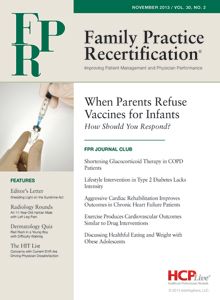Publication
Article
Family Practice Recertification
Exercise Produces Cardiovascular Outcomes Similar to Drug Interventions
Author(s):
New evidence suggests that physical activity and drug interventions are similar in terms of mortality benefits in the secondary prevention of congestive heart failure (CHF), rehabilitation after stroke, treatment of heart failure, and prevention of diabetes.
Frank J. Domino, MD
Review
Naci H, Ioannidis JP. Comparative effectiveness of exercise and drug interventions on mortality outcomes: metaepidemiological study. BMJ. 2013;347:f5577. http://www.bmj.com/content/347/bmj.f5577.
Study Methods
This was a meta-analysis of 16 previous meta-analyses and 305 additional recent randomized controlled trials with a total of 339,000 participants. The study data was evaluated to compare the efficacies of exercise and medication on 1 of 4 outcomes: The mortality benefits in the secondary prevention of coronary heart disease (CHD), rehabilitation after stroke, treatment of heart failure, and prevention of diabetes.
Patient Demographics
Patients within the CHD, heart failure, and pre-diabetes groups were all similar. Between 60% and 100% of patients with CHD had formerly experienced myocardial infarction (MI), and most patients in the heart failure group had a New York Heart Association (NYHA) Functional Classification of II-IV.
In the pre-diabetes group, patients had impaired glucose tolerance, obesity, and multiple cardiovascular (CV) risk factors. Concerning stroke patients, those who participated in the medication trials were enrolled within 2 weeks of stroke, while patients up to 150 days from stroke were included in the exercise studies.
Intervention and Control
Exercise interventions varied based upon the study that was included. The exercise for cardiac rehabilitation was typically a component of a larger comprehensive cardiac care program for those with CHD, which was delivered at in- and out-patient settings, as well as home settings. For stroke and congestive heart failure (CHF) patients, both aerobic and resistance/strengthening exercises were included. Those with pre-diabetes, primarily participated in aerobic exercise, which was a component of a multi-factorial intervention.
Results and Outcomes
Data analysis found no statistical differences between exercise and drug interventions in the secondary prevention of CHD and the prevention of pre-diabetes evolving to diabetes. However, physical activity interventions were more effective than pharmaceutical treatment in patients who were recovering from stroke (odds ratios, exercise versus anticoagulants 0.09, 95% confidence intervals [CI] 0.01 to 0.70; exercise versus antiplatelets 0.10, CI 0.01 to 0.62). The opposite was true for heart failure patients, since medications — namely in the form of diuretics — were more effective than exercise in the CHF group (odds ratio [OR], exercise versus diuretics 4.11, CI 1.17 to 24.76).
Conclusion
Based upon this analysis of limited data, existing randomized trial evidence on exercise interventions suggests that physical activity and many drug interventions are similar in terms of mortality benefits in the secondary prevention of CHD, rehabilitation after stroke, treatment of heart failure, and prevention of diabetes.
Commentary
This study undertook an enormous challenge in attempting to compare exercise as an intervention to medication trials in order to determine both methods’ influence on true patient outcomes, such as secondary prevention and mortality.
The limitations of this sort of meta-analysis begin with a lack of clear data on outcomes from exercise alone. Physical activity is often part of a multi-modal intervention — some of which include dietary changes, and many of which include drug interventions — so separating its influence out left a lot of data unavailable for analysis. When that data is available, comparing the populations of an exercise trial to a drug intervention study often means assuming that the patients’ demographics, habits, and disease severity are similar, which is unlikely to be the case.
An additional issue is that exercise alone isn’t a highly-funded area of research, because there’s no “vested interest” like a pharmaceutical company to underwrite the effort. There’s also the statistical challenge of performing a meta-analysis on meta-analyses, which is a type of data crunching that makes the arachidonic acid cascade look simple.
In light of all of those limits, the realization that enough data exists to inform us that exercise has the same efficacy as statins, aspirin, angiotensin converting enzyme inhibitors (ACEIs), and beta blockers for the secondary prevention of heart disease — as well as metformin, ACEIs, alpha-glucosidase inhibitors, thiazolidinediones, and glinides for the prevention of diabetes — is critical to this study’s effort. However, this doesn’t imply that exercise interventions are more effective than those medications, but it should make us question the efficacy of those drugs in preventing important outcomes.
Simply prescribing a medication regimen — as is often the case in our healthcare system — is likely a disservice to patients, so if you’re trying to prevent CHD in a high-risk population, it seems prudent to encourage both exercise and medication. In fact, we should regard both as necessary parts of treatment. If we instead focus on intermediate outcomes like low-density lipoprotein (LDL) cholesterol, then we will send patients a message of false security. For example, telling patients that their cholesterol “looks great” while they continue to make poor food choices, smoke, and refrain from exercise sends a message to those patients that they can “eat that steak as long as I take my pill.”
Israeli physicist Moshé Feldenkrais once said “movement is life” — a philosophy that’s part of osteopathic training, but often neglected in allopathic circles. Expecting an anti-coagulant to improve stroke outcomes compared to rehabilitation or medications to prevent heart disease should remind us that survival isn’t as valuable an outcome as being able to return to actively participating in society.
The take-home points here are that patient care requires motivating the patient to do more than administer medications. In fact, most of the world’s countries have made personal responsibility and exercise the mainstay of patient care, which is how nations with much higher rates of tobacco use continue to have longer life expectancy and higher quality of life than the United States. Thus, exercise is the key to living a long and enjoyable life.
We should explain these study implications to all patients in order to reinforce the notion that medication is a component of their health, but their physical activity is at least as necessary — and in most cases, more beneficial — than any combination of medications.
About the Author
Frank J. Domino, MD, is Professor and Pre-Doctoral Education Director for the Department of Family Medicine and Community Health at the University of Massachusetts Medical School in Worcester, MA. Domino is Editor-in-Chief of the 5-Minute Clinical Consult series (Lippincott Williams & Wilkins). Additionally, he is Co-Author and Editor of the Epocrates LAB database, and author and editor to the MedPearls smartphone app. He presents nationally for the American Academy of Family Medicine and serves as the Family Physician Representative to the Harvard Medical School’s Continuing Education Committee.






